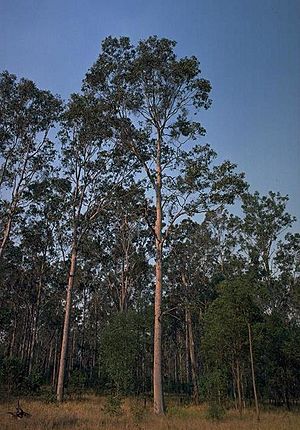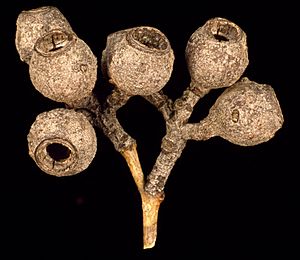Large-leaved spotted gum facts for kids
Quick facts for kids Large-leaved spotted gum |
|
|---|---|
 |
|
| Corymbia henryi near Grafton | |
| Scientific classification | |
| Genus: |
Corymbia
|
| Species: |
henryi
|
| Synonyms | |
|
Eucalyptus henryi S.T.Blake |
|
Corymbia henryi, often called the large-leaved spotted gum, is a type of tree that grows in north-eastern Australia. It's a medium-sized tree that has smooth, patchy bark. Its leaves are shaped like a spear, and its flowers are white or light yellow. The tree also produces fruit that looks like a barrel or an urn.
Contents
What the Large-leaved Spotted Gum Looks Like
The large-leaved spotted gum is a tree that can grow quite tall, usually between 25 and 30 meters (82-98 feet). It has a special woody swelling at its base called a lignotuber. This lignotuber helps the tree regrow after things like bushfires.
The bark of this tree is smooth and has a cool, mottled (patchy) look. It can be grey, cream-colored, and even pink.
Leaves and Flowers
Young trees and new shoots have leaves that are broadly egg-shaped or spear-shaped. These leaves are quite big, about 8 to 25 centimeters (3-10 inches) long and 4 to 10 centimeters (1.5-4 inches) wide.
The adult leaves are glossy green on both sides. They are also spear-shaped, measuring about 11 to 28 centimeters (4-11 inches) long and 2.2 to 4.5 centimeters (0.9-1.8 inches) wide. Each leaf narrows down to a stalk called a petiole, which is about 1.5 to 3 centimeters (0.6-1.2 inches) long.
The tree's flower buds grow in groups of three at the ends of its branches. Each group of three buds sits on a small stalk. The mature buds are oval or pear-shaped, about 12-13 millimeters (0.5 inches) long and 6-8 millimeters (0.2-0.3 inches) wide. They have a pointed cap called an operculum.
You can see these trees flowering in January, April, and November. Their flowers are either white or a pretty lemon-yellow color.
Fruit
After flowering, the tree produces woody fruit. These fruits are shaped like a barrel or an urn. They are about 9 to 15 millimeters (0.35-0.6 inches) long and 9 to 16 millimeters (0.35-0.6 inches) wide. The parts that open to release seeds (called valves) are tucked inside the fruit.
The large-leaved spotted gum looks a bit like the lemon-scented gum. However, it doesn't have that strong lemon smell. Its leaves, flower buds, and fruit are also bigger than those of the lemon-scented gum.
How the Tree Got Its Name
The large-leaved spotted gum was first officially described in 1977 by a scientist named Stanley Thatcher Blake. He called it Eucalyptus henryi at that time. Blake collected the first samples of this tree near Stafford in 1956.
Later, in 1995, two other botanists, Ken Hill and Lawrie Johnson, changed its name to Corymbia henryi. The "henryi" part of its name is a way to honor "Mr. N. Henry of the Queensland Department of Forestry."
Where the Large-leaved Spotted Gum Lives
You can find Corymbia henryi growing in forests. It usually grows on flat ground. Its range stretches from areas near Brisbane and Toowoomba in Queensland, all the way down to near Glenreagh in New South Wales.




